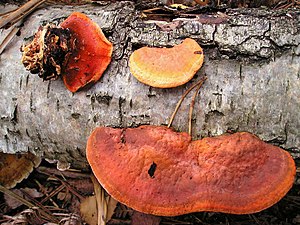Northern cinnabar sponge
| Northern cinnabar sponge | ||||||||||||
|---|---|---|---|---|---|---|---|---|---|---|---|---|

Northern cinnabar sponge ( Pycnoporus cinnabarinus ) |
||||||||||||
| Systematics | ||||||||||||
|
||||||||||||
| Scientific name | ||||||||||||
| Pycnoporus cinnabarinus | ||||||||||||
| ( Jacq .: Fr. ) P. Karst. |
The Northern cinnabar sponge or short cinnabar sponge ( Pycnoporus cinnabarinus ) is a species of fungus from the family of Stielporlingsverwandten . Although the mushroom is not one of the “real” Trametes ( Trametes ), it is also known as Vermilion Tramete or Zinnobertramete .
features
The northern cinnabar sponge has a 2–10 cm wide and up to 6 cm console-shaped protruding from the attachment point, 1–2 cm thick fruiting body . The surface is irregularly bumpy and warty. The color is usually a conspicuous vermilion, orange-red specimens also occur. With potassium hydroxide , the flesh turns black. The 1 (–2) -year-old fruiting bodies are indistinctly zoned concentrically and have a slightly wavy, bent edge. The angular and elongated pores are arranged in a labyrinthine manner and are relatively fine (2-3 per mm). The meat is tough, leathery and hard, corky and orange-red in color. The smell and taste are inconspicuous.
ecology
The northern cinnabar sponge is a saprobiontic wood dweller who colonizes hardwoods; The preferred substrate in Central Europe is the common beech . In addition, other hardwoods, more rarely conifers, are populated. Together with the common split-leaved leaf and the curly tramete, it is one of the first to colonize dead, still standing or lying trunks or trunks, lying trunks, twigs and branches exposed to light, but can also occur in later decomposition phases. The northern cinnabar sponge occurs in light, rather dry beech and hornbeam oak forests. As a very light and heat-loving species, it rarely occurs within closed tree stands, but prefers clear-cutting, clearings, forest edges, hedges, orchards, parks and gardens.
distribution
The northern cinnabar sponge occurs in the Holarctic from the warmer to the boreal zones, it is found in northern Asia, North America and Canada. It is rarely found in South America and South Asia (India). In Europe, the species is widespread from Spain and Italy to the 71st parallel and to the Urals. It is rarer in the Atlantic area, it is essentially absent in France, the Netherlands and Ireland, and it is rare in eastern Great Britain and Denmark. In Germany, the species is widespread throughout the country, but is absent in some areas of northwest Germany and in the central and southern German coniferous forest areas.
The northern cinnabar sponge has experienced strong population fluctuations in the past, the causes of which are not fully understood. After it was evidently frequent and widespread in the first half of the 19th century, it decreased sharply until around 1960, and then spread again. One possible cause could be the lower use of reading wood, which resulted in suitable locations on piles of wood and brushwood.
meaning
The northern cinnabar sponge is not an edible mushroom, as a wood decomposer it is insignificant.
literature
- German Josef Krieglsteiner (Ed.): The large mushrooms of Baden-Württemberg . Volume 1: General Part. Stand mushrooms: jelly, bark, prick and pore mushrooms. Ulmer, Stuttgart 2000, ISBN 3-8001-3528-0 .
- J. Schliemann, F. Zadrazil: Investigations on the potential substrate spectrum of Pycnoporus cinnabarinus (Jacq. Ex Fr.) Karst. In: Journal of Mycology . tape 41 , no. 1-2 , 1975 ( dgfm-ev.de [PDF; 2.1 MB ]).
- J. Schliemann, F. Zadrazil: Investigations on the potential substrate spectrum of Pycnoporus cinnabarinus (Jacq. Ex Fr.) Karst. 2nd communication. In: Journal of Mycology . tape 44 , no. 2 , 1978, p. 291–294 ( dgfm-ev.de [PDF; 1,2 MB ]).

